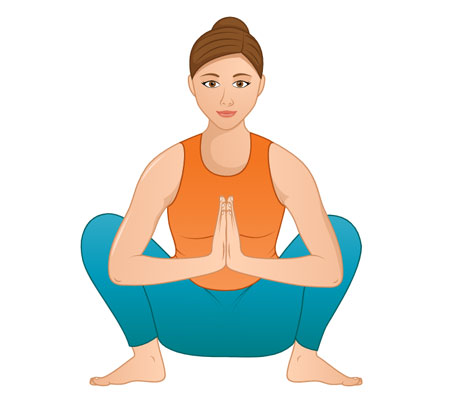Prayer Squat Pose

STEPS
Beginning in Tall Mountain pose (Tadasana) The Pose – Step the feet out to shoulder width with the feet at a 45° angle (toes pointing out towards the edges of the mat). Slowly bend the knees coming down to a low squat with the knees wide. Bring the palms together in prayer pose (Anjali mudra). Inhale and press the elbows against the inside of the knees. Exhale and extend the arms between the legs releasing the neck and head towards the floor. On the inhale return the arms to prayer and repeat 3-5 times. To exit the pose, bring the hands in front of the feet. On the inhale bring your weight into the hands and arms. On the exhale slowly extend the legs to a forward bend. On the inhale roll all the way up – one vertebra at a time back to Tall Mountain.
TEACHER QUEUES
VISUALIZATION COMMENTS
The squat can be an awkward pose for new students . Try using phrases such as – Gently press the palms together in prayer bringing openness and grace to the hips and pelvis. Relax the shoulders and let the shoulder blades melt down the back. Invite the students to focus on the breath and support their awareness of the benefits of yoga for the body with commentary such as –Observe the stretch of the groin and hips in prayer change as the arms, head and neck release forward. The squat is also a popular pose for pregnancy yoga as this pose supports the birthing process and helps to alleviate back pain during labour.
TECHNICAL COMMENTS
The feet should be flat and well-grounded. Elbows need to be on the inside of knee (pressing into the soft crease – not the knee itself). The bottom should be low but not touching the heels or ground. Breathing is an important part of this pose – Inhale when pressing the palms together and exhale when extending them forward. The palms in prayer should be at heart level with wrists, lower arms and elbows in alignment to encourage opening in the shoulders and neck.
BENEFIT COMMENTS
- Strengthens and tones thighs and hamstrings
- Improves strength and flexibility of shoulders, arms and knees
- Increases flexibility of hips
- Improves digestive complaints such as constipation and wind (gas)
WATCH OUT FOR
- Heels off the ground (open legs wider or place blocks or folded mat under heels)
- Bottom in the air (bring weight into heels and draw tailbone down)
- Bottom touching heels (bring weight into toes and lift up from lower belly)
- Elbows on or in front of knees )widen the feet slightly)
CONTRAINDICATIONS
- Knee injuries
- Sciatica
MODIFICATIONS
Students with tight hips or Achilles tendons may find their heel come off the ground in a squat. Placing blocks or a folded mat under heels helps to support this part of the foot and encouraging the tendons to release without strain. Opening the feet wider than hip width will also help to release tight hips and/or heels. Placement of blocks under the bottom as well as the feet can provide extra support to those new to this pose or in later stages of pregnancy.
VARIATIONS
- Dynamic low squat sometimes known as chopping wood pose. Bring the hands above the head with fingers interlocking. Inhale looking towards the extended arms and stretching the spine. Exhale the breath through the mouth using the Ha sound and bringing the arms to the ground in one swift motion. Repeat 3-5 times.
- High squats with legs wider than shoulder width. Bring hands to prayer, eagle arms or cow arms. These might be combined with wide leg forward bends or dynamic squats (exhale the squat lower and inhale to rise up)
- High squat with side angle stretch. Bring right forearms to right thigh. Inhale and lift the left arm up over the head. Hold for 3-5 breaths. Repeat the other side.
YOGA COUNTER POSES
- Knees-to-chest (Apasana)
- Alternate knee-to-chest pose( Supta Pawnanmuktasana)
- Forward bend (Uttanasana)
- Seated Forward bend (Paschimottanasana)
Written By: Brenda Hamlet RYT 200
Brenda is a yoga teacher and journalist in Oxford, England. More information about Brenda can be found at www.pret-a-yoga.com



